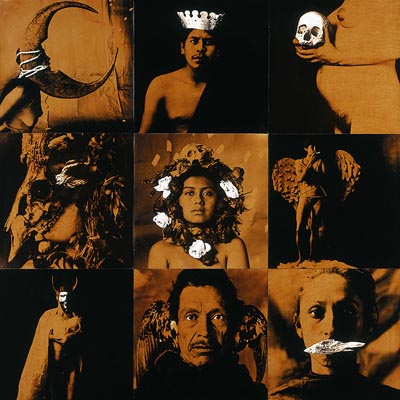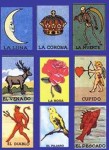

Luis González Palma
Guatemalan, 1957-
Lotería I, (Lottery #1), 1989-91
hand painted silver gelatin prints, mixed media, ed. 1/5
57 x 58 ½ in.
SBMA, Museum purchase with funds provided by the Wallis Foundation
1995.10

González Palma as one of his subjects.
“If you can explain a poem, it is not a poem. Poetry has to be inexplicable. And it is impossible to explain the emotion of the violin from Bach. You can talk about something, but to explain why you feel things . . . you can’t. So I try to have an emotional impact, not with words or sounds, but I try to get these deep emotions from images.” - Luis González Palma
RESEARCH PAPER
A self-taught photographer from Guatemala, Luis González Palma creates expressive works of art that are often about contradiction. His portraits of Mayan Indians present a tragic vision of life that is full of pain and beauty. Often collaged with images of contemporary symbols, objects, and icons, the pictures act as records of life in a country where violence and mysticism coexist. At the same time, the overwhelming sense of humanity in each picture speaks to the photographer's ability to transcend cultural boundaries and tap into a pool of shared experience.
One of the most recognizable aspects of González Palma's photographs is their deep sepia tone. He achieves this by painting a standard black and white print with asphaltum, then further manipulates the image by removing the asphaltum from key areas, returning them to the original white of the photograph. The process turns the pictures into tangible objects with a sense of history, creating a dialogue with the past that works toward a realization of the complex social legacy of Guatemala.
Lottery I is a photographic work by contemporary Guatemalan photographer Luis González Palma. It is composed of nine individual staged portraits that he made from 1988 to 1989, and arranged in the format of a playing board for the popular Latin American game, Lotería.
The Lotería game is very similar to Bingo. It was brought to the New World by the Spanish, who used it to teach Spanish to the indigenous peoples they conquered. Each player receives a small board with nine different images. As cards are drawn one by one from a deck, the players try to be the first to match all the images on their board. González Palma has portrayed nine Lotería cards in his work, and although his images are quite different from the traditional pictures on the game cards, Mexicans and Guatemalans who visit the Museum easily recognize them.
González Palma's models are indigenous Guatemalans, descendents of the ancient Mayans. His portraits do not represent individuals, but rather archetypal, mythological characters with mystical attributes. He paints over his black and white prints with a dark sepia medium and purposely batters them, suggesting their long and violent passage through history. The darkened tone has been compared to the surface of paintings and frescoes that have hung in Catholic churches for centuries, exposed to candle smoke and incense. González Palma rubs off the dark glaze in some areas, revealing the white of the paper below, and emphasizing specific attributes such as roses, rope, and most importantly, the eyes.
The most immediately engaging aspect of Lottery I is the intense gaze created by the whiteness of the eyes. González Palma says that Mayan people in Guatemala always look away when approaching someone of European descent, or step off the sidewalk to allow the European to pass. "Everyone will be forced to look in the eyes of the Mayan people in my photographs," he says. The portraits stare directly into our eyes with an arresting, hypnotic gaze establishing a metaphor that is central to much of the artist's work; that the life of the indigenous Guatemalan people transpires in darkness (the sepia tone) although their spirit (the glistening eyes) prevails and endures. The eyes appear as "windows to the soul."
Luis González Palma has revealed very little of his intended meaning in these symbolic portraits. Many of his allusions are clear; others remain intentionally shrouded in mystery. Lottery I is best discussed by looking at each portrait individually:
La Rosa (the Rose ):
As the center image, with her face surrounded by bright white, La Rosa is probably the portrait most viewers notice first. She embodies González Palma's vision of human existence, which is essentially tragic. He sees human life as universally beautiful and sad, just as the face of La Rosa is at once beautiful and sad. A close look at her headdress reveals wilting roses in sepia tone mixed in with the fresh white roses. Her beautiful, young face contrasts with the small skull at the top of her headdress. These are references to religious themes of European Baroque "vanity" paintings; reminders that everything in life fades and dies.
La Luna (the Moon):
Evokes several layers of meaning. The model poses as a personification of the moon. The moon prop is tied to her face with rope, in a way that lets her profile form the face of the moon. She is bound to the moon, as women are universally tied to the moon through their monthly cycles. But she is also bound and gagged, bringing to mind a long history of violence and subjugation in Guatemala. The ancient Mayans sacrificed human victims to their gods. The Spanish conquered and enslaved the Mayan people. The Guatemalan military government killed more than 200,000 Guatemalans from the early 1960's to the late 1980's. Most were defenseless civilians suspected of guerilla activity. Entire villages were wiped out; torture, rape and murder were common. La Luna's nude body, the rope around her waist and the suggestion that her arms are tied behind her back create a sense of impending violence, which is at odds with the beauty and mystical quality of the photograph.
La Corona (the crown):
The Mayan, once king in Guatemala, wears a paper crown of European style. The crown is a cheap, disposable item, as are all González Palma's props; rope, a paper devil's cape, paper angel wings, and backgrounds of brown butcher paper held together with tape. Perhaps he alludes to the transitory nature of governments, religions, and cultures. The brown paper relates to both the past and the present; ancient Mayans wrote their Codices on brown paper made from the bark of the fig tree. Here the paper hangs as a background for a staged photo shoot, emphasizing the fact that these are contemporary photographs of living people, taken in a studio.
La Muerte (Death):
Shows a nude pregnant woman holding a skull. The obsession with death, personified by a skull or skeleton, is a pervasive part of Mexican and Guatemalan culture, as celebrated in the Day of the Dead. González Palma also refers to 17th century Spanish paintings depicting a figure meditating with a skull, signifying "memento mori", literally "remember your mortality." The disquieting image of woman about to give birth meditating on death evokes again the atrocities committed by the military government. "I live in a country where there is so much mysticism and so much violence at the same time," he has said, "where as you are enjoying nature, the helicopters are flying overhead and you know they are going to bomb some region; where you know that as you are working, someone is being killed or someone is being baptized." In this context, "memento mori" relates to both Catholic ideology imported by the Spanish, and horrific daily reality for Guatemalans.
El Venado (the Deer):
Shows a woman's face in profile, wearing a deer skull tied on with rope. The antlers are visible at the top of the frame. In remote areas of Guatemala, indigenous men wear a deer mask while performing the Deer Dance, derived from ancient Mayan hunting ritual.
Cupido (Cupid):
Is a mythical figure from ancient Greece, shown here with the large wings of a Catholic angel. The wings have been tied onto an androgynous figure, who smokes a cigarette, clearly bored and rebellious. European culture and Catholicism have been imposed upon this indigenous Guatemalan. Love, in the form of Cupid, appears to be taking a break.
El Pescado (the Fish):
Is the symbol of Christianity, a Spanish import to the New World. Christianity appears to have silenced this woman.
El Pajaro (the Bird):
Staring straight into our eyes with bird wings attached to his head, The Bird suggests shamanistic metaphysical transformation.
El Diablo (the Devil):
In Guatemala, the Devil has taken on qualities of Mayan gods, evolving into more of a mischievous trickster than the Christian embodiment of evil. Indigenous Guatemalans wear devil masks such as this during festivals and parades. The Devil and Cupid figures are relatively smaller that the other portraits, showing the full body. They appear doll-like, bringing to mind small angel and devil figurines that would be placed on an altar, as for the Day of the Dead.
Luis González Palma was born in Guatemala in 1957. He trained as an architect and cinematographer at the University in Guatemala City. His interest in creating staged portraits developed when, as a favor, he began taking photographs of his dancer and actor friends on stage. He was 33 years old when he created Lottery I. González Palma describes himself as a Postmodern Romantic. His greatest artistic influence is the Romantic English photographer, Julia Margaret Cameron, who created dramatic staged portraits of her family and friends in the late 1800's. French artist Christian Boltanski (creator of SBMA's Gymnasium Chases) has been an important influence on González Palma's recent work, in which he uses identification photos of victims who "disappeared" during Guatemala's long military dictatorship.
González Palma presents his characters as cards in a game of chance, in which there are winners and losers. He creates a sense of the many shifts in fortune and events that have affected the Guatemalan people over time. The ancient Mayan culture, the Spanish Conquest, Catholicism, Mysticism, Guatemalan politics, and popular culture all play into his staged portraits. Western artistic traditions figure prominently as well; photography itself sprang out of Western European culture, as did realistic individual portraiture and the artistic nude. In spite of his many symbolic allusions to history and culture, González Palma strives to elicit an emotional response from the viewer, not an intellectual one. His models are Guatemalan, but the dominant theme in all his work is the universal human condition; the sadness, pain and beauty of life.
Prepared for the SBMA Docent Council by Kathryn Zupsic, November 2006
Sources
Castro, Fernando R. Light and Darkness, Song and Scream, the Photographic Work of Luis González Palma. Online article. Zone zero website. www.zonezero.com/magazine/articles/castro/gonzen.html
González Palma, Luis. Poems of Sorrow . Essay by John Wood. Arena Editions, Santa Fe, 1999.
Rain Taxi Review of Books . The Post Modern Romantic: An Interview with Luis González Palma . Online. www.raintaxi.com/online/1999spring/palma.shtml

Photo of Luis González Palma, 2010.
SBMA CURATORIAL LABELS
Lottery #1 explores themes prevalent in Luis González Palma’s work: Catholicism, mysticism, and colonialism. The work is composed of nine separate photographs arranged in the format of a playing board for the popular Latin American game lotería, which was used by colonial missionaries to teach Spanish to the Maya. Palma has reworked selected cards from the game including The Moon, The Crown, The Rose, and The Devil.
In composing this work, Palma photographed indigenous Guatemalans of Maya descent, with props in his studio. He painted over his black-and-white prints with a dark sepia wash to confer a sense of age and history, rubbing off the dark stain in some areas to reveal the striking white of the paper below. In these haunting images, Palma has created his own mythic world that transcends space and time, filled with beauty and violence, life and death.
- Myth and Materiality: Latin American Art from the Permanent Collection, 2013
Lotería #1 unites nine separate photographs which together explore themes common in Luis González Palma’s work: Catholicism, Guatemalan mysticism, and issues of colonialism. Based on a sixteenth-century card game used by colonial missionaries to teach Spanish to the Maya, Lotería #1 reworks selected images from this card game in the “fabricated-to-be-photographed” style of United States photographer Joel-Peter Witkin.
In composing this symbolic collage, González Palma photographed live models with props in his studio and then reworked the resulting prints by hand. The varying views of partial human figures present a range of meanings, from the demonic to the angelic and the alchemical to the mystical, suggesting the admixture of indigenous Maya beliefs and imported Spanish doctrines that characterizes González Palmas’s native Guatemala.
Guatemalan Luis González Palma trained first as an architect, renders full-blown portraits against a wrinkled studio backdrop with unflinching intensity. Beginning with a black and white photograph, González Palma manipulates, paints, cuts, and often reassembles his prints. Some of his works are like altarpieces, assembled in twos and threes; others come straight from popular culture as in Lottery. Hand washed with black and sepia toned paints, González Palma weights the subject to the earth. The only relief comes from startling white highlights emanating from the eyes of his symbolic figures or the objects, such as roses, crowns, or fish. A young woman wreathed in roses is dignified and proud, yet she seems to bear an enormous weight. A child wearing a crown of thorns stares straight ahead, unemotionally, seeming ancient in his acceptance of his lot.
González Parma composes his imagery in a formal, architectonic style, with each photograph focusing attention on the sole existence of the figure contained within a nearly suffocating frame. His figures bespeak an ode to the dignity and suffering of common people.
- SBMA Wall Text, 2000
